Introduction
In a previous note,(1) I have already reported the results of some further reflection driven by comments of tarot experts on earlier notes. Here is a more complex case, stimulated by a comment of Thierry Depaulis(2) on another note of mine(3): he suggested a preferably different reconstruction for the fourth Rosenwald sheet, with that block to be used for printing the 10s, whenever required. He reminded me that this possibility had already been suggested by nobody less than Michael Dummett.(4)
Now I will go on, speculating how ancient packs of cards could have been produced. This is a usual charge among card historians: the difference is that I will try and put myself in the shoes of a cardmaker, instead of the more usual attempt to recreate a whole card pack on the basis of some remaining cards that once belonged to it.
1. Naibi by dozen
We have seen(1) that naibi were ordered in pairs; now, I try and extend that ordering. As indicated in the title, I intend to deal with naibi and dozens, or better with naibi seized by the dozen.
Common card packs were sold by the dozen. On the other hand, dozens of cards are usually evident within each card pack, associated with the suits, generally four dozen cards corresponding to the four suits of a pack. We can find many cases in which a given suit did not correspond to a dozen cards; some of them clearly were the result of later modifications; with some others I will deal at the end of this note. As for other cases, I will begin my discussion without considering the very few occasions in which an odd number of suits was present, as in early 5-suit packs from Germany, and similar specimens (one special case will however be present in the end).
We can thus begin with two dozen cards and go on, with even numbers of dozens. Let me list the few possible packs, which we encounter in this speculative exploration.
- 2 dozen – one woodblock, or one paper sheet; half-pair of cards, half a common pack.
- 4 dozen – two woodblocks, or 2 paper sheets, or 1 pair or 1 pack of 48 cards.
- 6 dozen – three woodblocks or 3 paper sheets, or 1 triumph pack of 72 cards, or a quasi-tarot (to discuss later).
- 8 dozen – four woodblocks, or 4 sheets, or 1 minchiate pack of 96 cards, also to discuss below.
A greater number of dozens could only be used for producing more than one pack of cards: with 8 dozen we already have a full pack of minchiate - except the Matto to be added apart - the thickest pack offered to card players. If we were interested in different items, then we could have found a further significant stage with twelve dozen, corresponding to one gross, a unit once widely used for trading greater quantities of goods.
2. From 48 to 96 cards
Three tarot sheets are known in the Rosenwald collection and I suggested that with a fourth one a pack of minchiate could be obtained. (3) This could not be an exact reconstruction, first of all because there was a missing Queen of Batons, and a useless supplementary Popess. As soon as I dare neglect this Popess-Queen "mistake", I am left with only one problem: a minchiate pack has 97 cards, whereas "my" four sheets only produce 96 of them. Here I find experts, however, who somehow support my opinion.
First of all, the same Michael Dummett, in another article(5), also reminded to me by Thierry Depaulis: he clearly states that the Matto could have entered the pack only later on. As a second supporting suggestion, I may quote the case, indicated to me by Lothar Teikemeier(6), of a figure that comes from Florence - second half of the 15th century: in it we see the figure of a Bagatto, which is however provided with some typical features of a Matto.(7)
I would make some use of common sense too: any pack of cards should better be formed by a number of cards that can equally be divided among the players: better if a multiple of four, or at least of two. 96 has the advantage that it can be equally divided among 2,3,4,6,8,12,16,24,32,48 players! On the other hand 97 is a prime number and, if you wish to deal all the cards equally to every player, you can only deal 1 card to 97 players. In my opinion, the 97th card of minchiate was born as a wild card, a card that could be made apart, in various ways, according to the purchasers, and that did not therefore require to be inserted in the "common" four woodblocks.
If we neglect the Matto, there remain 40 triumphs in the pack of minchiate, which "balance" the 40 pip cards of the four suits, and are present together with the 4x4=16 court cards. These 40 cards can be divided easily into two groups: the first with 20 "old" triumphs, from 1 to 15 and from 36 to 40; the second with 20 "new" triumphs from 16 to 35. On its turn, it is easy to subdivide the latter group into the 4 virtues (16 to 19), the 4 elements (20 to 23), and the 12 zodiac signs (24 to 35).
Should this be required, it would be easy to similarly subdivide the 12 zodiac signs into three further groups of 4 cards (even though dividing a year into three four-month periods is not as common as the seasonal division into four groups of three months). As a whole, we can see these "new" 20 cards as five groups of four cards each.
Let us see if a similar division into subgroups looks is possible for the "old" triumphs too. Unfortunately, I have not been able to find such a division in a convincing way. I have added my personal comment of "unfortunately" for a precise reason that will become clear later on.
I insert below my suggested reconstruction of the further two blocks required for passing from a naibi 48-card pack, as encountered before(1), to a minchiate one.
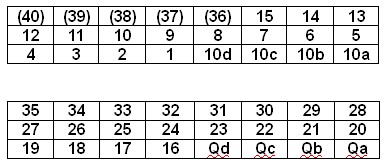
This appears as a good solution, but only in the case that all the four blocks are really used. What about any pack to be made using just three blocks?
3. How to make use of 72 (amid 48 and 96) cards
With respect to minchiate, we know with certainty that packs of triumphs with less cards existed at the time, and later on; apart from Florence, and a few other places, the 96/97-card pack was only a thicker and exceptional instance. Now, it would be tempting to produce a triumph pack with just three blocks instead of four, obtaining a quasi-tarot of 72 cards - namely, six dozen cards.
The search of the "best" third sheet can be done either starting from the previously discussed 96-card pack or straightforwardly from the 48-card one; in any case, some discussion must be dedicated to the difference between the 72-card pack and the more widespread 78-card "standard" tarot.
How could our third block be formed, starting from the previous minchiate tables? My preferred 3rd block would not be that outlined in the table, but instead one in which both the four 10s and the four Qs are present. If however I put the four Queens of the second table into the first one, I don’t see which four cards I have to move, in the place of the Queens, from the first table into the second.
If we had to eliminate a quartet of triumphs among the "new" ones of minchiate, we only had the problem that they were hard to remove from the 12 zodiac signs, to be possibly kept together, but either the 4 virtues or the 4 elements could be easily taken out. Unfortunately, I am not able to find a similar quartet of cards that can be eliminated in a logical way from the "old" twenty triumphs. Except for the 10s, the cards of the first table are not so easy to divide into groups of four. In case, these twenty cards appear to be easier to collect in groups of 5 (1 to 5, 6 to 10, 11 to 15, and 36 to 40), even if not as sharply defined.
Well, let me then examine any reasonable way for obtaining "my" 72-card triumphs, starting instead from the "standard" 78-card tarot. Let me begin with taking both Matto and Papessa away from the 78 cards. Namely, I assume that Matto was added only later on, and that Papessa was not present in the Florentine packs (which in my opinion could be at the origin of those adopted in other places – I know that this whole beginning can be questioned, but let us go on). My problem now is that I have to eliminate a further quartet of cards and it can be selected from any of the three components of the pack.
I can start with pip cards, and just eliminate the four 10s. Packs without them were common and it is possible that the 10s were only added to the first packs of triumphs in a later time. Once we have completed a pack of quasi-tarot lacking the 10s, we find a further option for completing it. If cards were made for Florence, they needed the fourth sheet with the four tens and the 20 "new" triumphal cards. If they were made for other places where the 10s were needed, and not the 20 new cards, we could have a different fourth sheet, only made for producing the 10s. In the last case, one could still use a 3x8 pattern, thus obtaining six sets of the four 10s on a single sheet. Such blocks for producing only the 10s have been kept, and commented on.(3)
Also from court cards I can easily eliminate a quartet. In this case, I would prefer to eliminate the four Queens, but cannot be sure of this. Here I have even the choice between the four Queens or the four Knights, in analogy to many Italian "ordinary" packs in which the choice was precisely whether to use either Queens or Knights.
Finally, there is the third and last possibility: we can eliminate four of the remaining twenty triumphal cards. In principle, this could be the easiest task, because exactly 16 were the first "original" triumphal cards that we know at present, those devised by Marziano. In my opinion, the originality of Marziano suggestion could consist in the particular figures that he attributed to the 16 triumphal cards; the structure of that pack could just replicate one already in use.
Unfortunately, I am not able to select the mentioned series of 16 triumphal cards; I would be delighted to consider the 40 triumphs of minchiate divided into two groups of 16 and 24, respectively, instead of the two groups of 20 of the tables above. On that basis, with the three blocks we could make a pack ready for export in some places (with however Papessa and/or Matto that could require some changes later on). Easier to understand could be the use of the fourth block, in this case with the "new" 24 triumphs directed only to Florence and the other towns were the full pack of minchiate was adopted by local players.
4. Other bases
All that I have discussed up to now has been on the basis of dozen cards, as already indicated in the title itself. What about the consequences of selecting different bases for the woodblocks and the card sheets? The discussion above maintains most of its validity and it is possible to find new interesting "solutions" just by changing somewhat the numerical basis. Let us examine what happens if we chose 13 or 14 instead of 12.
If 13 is the new basis, we find something interesting too, which most readers may even find preferable to the 12 basis. The most usual card packs of nowadays consist in 52 cards; namely, four suits, each formed by precisely 13 cards, 10 pips and 3 court cards. Let us produce it in the ancient way, with woodblocks. As before, just one suit has no sense, two suits correspond to one woodblock (with now 26 cards instead of 24) or half a pack. To obtain a pack (a pair of naibi, they said) we need two such woodblocks, with the four suits. Which are our 3 court cards? Let us assume King, Queen and Jack. What we have obtained is very familiar to us.
Probably, an even greater advantage of this system arrives however just now, when we add the third woodblock for obtaining another card pack, also very familiar to us: nothing less than a pack of the "standard" 78-card tarot! As a matter of fact, our third block only needs precisely the four Knights (or the four Queens if we had already inserted the four Knights in the two first sheets) and the whole 22-card series of the triumphal cards typical of the "standard" tarot.
In no case, to my knowledge, has this bizarre sequence found a similarly simple justification – at least as far as its number of cards is concerned. It is not a logical necessity of the sequence to consist in 22 figures: it is not a mystic, coherent, and complete sequence; it just corresponds to the empty spaces remaining in the third woodblock.
Why have I only appended this beautiful construction after the longer discussion on the 12-card basis? Because I like very much the pack that has been used here for centuries, the 96/97-card minchiate. The problem with the 13-card system under examination is actually that when we pass from the 3 to the 4-sheet pack, the "following" pack that we obtain is formed by 104 cards.
Now, we are accustomed to use such a thick pack too. We even use it now for patience games ! Clearly, it is formed by two identical 52-card packs, but this proves that such a double pack is handy enough for playing with it.
Why then this thick pack is for me very hard to accept? I have just one reason not to like it: if I accept this idea, it becomes a task of mine that of imagining a minchiate pack provided with 5 or 6 yet additional cards, and I prefer to keep this charge away from my already drained imagination. In particular, I suppose that the formation of the minchiate was not much later, with respect to other triumph packs, so that the use of a reduced fourth woodblock could hardly be accepted, for producing only about 19 cards.
Let us thus see next what can occur if we pass to a 14-card basis. Here again we can find something interesting, even if probably somewhat less convincing than in previous cases. Having 28 cards per block, with two of them we already obtain a "full" pack of 10 pips and all the four court cards that we find present in tarot and in a few other packs, with a total of 56 cards. This looks promising. The problems arrive however with the triumphal cards. To envisage a triumphal sequence of 28 cards is again a hard assignment. (We know that in minchiate we even had more of them, but no variant with a number similar to 28 is known, at least to me.)
If I had to visualise a triumph pack on this basis, I would adopt a different fourth sheet, with two identical parts of 14 cards each. In other words, I could easily accept a triumph pack with a new "fifth" suit, that of triumphs, precisely consisting in the same number of cards as the four "common" suits. (Obviously, the second sequence of 14 cards could be inserted in another pack – which means that this woodblock had to be used once, when using twice the remaining two.) The usage of 70-card triumphs has been documented in Ferrara, and this has already been interpreted as a five-suit pack.(8)
What about the fourth pack and "my" minchiate? No solution is in sight and we cannot think of a similar fourth sheet here, once we have used only half of the third one. The total number of cards that could be produced with the "usual" four sheets would now become of 112, which I leave completely to see in your mind’s eye.
Conclusion
As soon as cards were produced with the use of woodblocks, and this occurred earlier than commonly supposed, a certain standardisation of the whole pattern became necessary, if it was not already present among the cards of the years before. In particular, one had to think in terms of groups of cards, and of card sheets, rather than of individual cards. No solution exists, if one wishes to use similar woodblocks for producing common card packs and, with more and more of them, both the "standard" augmented packs of 78 and 97 cards.
It seems to me that working by dozen was a good guide for the mentioned standardisation. With one woodblock and a single sheet of paper, no useful card pack could be obtained, and therefore the simplest card pack was produced with two sheets of paper, 48 cards, and already acquired the attribute of a pair.(1) With three woodblocks a quasi-tarot pack of 72 cards could be made, and finally, with the use of an additional fourth woodblock, a 96-card minchiate pack could be produced. The passage then from 96 to the "normal" 97-card minchiate pack could occur with the insertion of the new Matto card. Fortunately, for the last assumption, I found some support in the opinion of nobody less than Michael Dummett.(5)
It is possible to look for series different from the 48-72-96 first described. Further bases and systems, similarly hypothetical, have been discussed above, with which various cards packs could be produced; they can be considered more or less convincing, but all of them were not suitable for producing a minchiate pack. We can even obtain the "standard" 78-card tarot in the series 52-78-104, with very suitable first two numbers, but with the last one apparently too high, even for minchiate.
At present, it seems to me that all the mentioned hypotheses have pros and cons, whereas we should better find the fully convincing one. To find new documents, which can provide the one and only solution, will be much better than all these discussions. By the way, in that research I am fully engaged just now.
Footnotes:
(1) Franco Pratesi: Naibi by Pairs (2012)
(2) Thierry Depaulis, Personal Communication, January 2012.
(3) Franco Pratesi: Rosenwald's Fourth Sheet (2011)
(4) Michael Dummett, The Playing-Card, Vol. XXXIII, No. 1 (2004) 24-26.
(5) Michael Dummett, The Playing-Card, Vol. XXXII, No. 4 (2004) 165-167.
(6) Lothar Teikemeier, Personal Communication, January 2012.
(7) Michael J. Hurst: Pre-Gebelin Tarot history, September 2010 - at the bottom of the page
(8) Trionfi.com: 5x14-theory
Side bar pictures and text added by Lothar Teikemeier
|
Selfmade photoshop variations according details from Baccio Baldini's "Children of the moon" c. 1465:
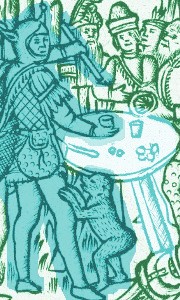
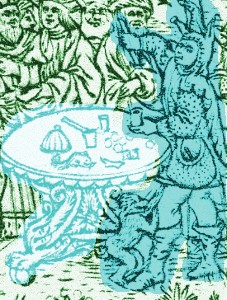
The Magician of the Rosenwald Tarocchi carries a similar Fool cap as the Baldini Magician.
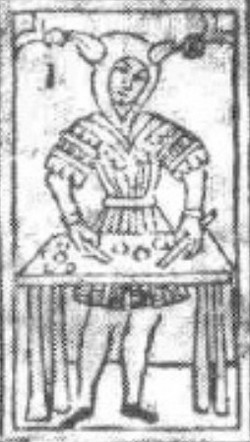
The oldest notes about the game Minchiate, once found by Franco Pratesi, appeared 1466, 1470/71 and 1477, then surprizing other Tarot History researchers, who had given the begin of Minchiate games to early 16th century. The Baldini pictures appeared in a similar time as this new game Minchiate, and they are considered to be between the first known examples of engraving use in Italy. Baldini, working in Florence, is seen as the follower of Finiguerra (1426 - 1464), and Finiguerra was considered as the inventor of engraving technology in Italy by Vasari.
Under these conditions there's some plausibility, that the Rosenwald Tarocchi might have been a very early example of Minchiate, as suggested by Franco Pratesi recently and possibly the oldest, which we know of.
Magician (Bagatello) illustrations are not rare between the "children of the moon" pictures (occasionally also at "children of mercury"). But they usually don't present the Bagatello with the typical Fool cap with ass ears.
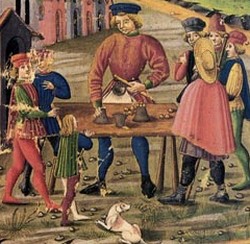
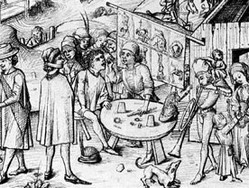
The considerations led to the assumption, that th roles of Magician and Fool might have been merged to one figure in the early time of Minchiate.
A similar merging process is observable much later in the "Petit Oracle des Dames", which appeared in France c. 1800.
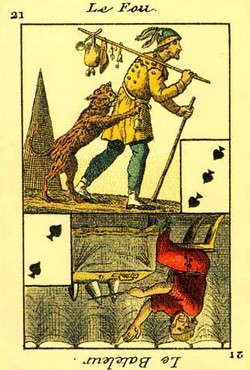
|
|








